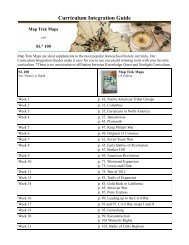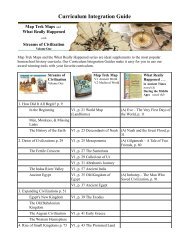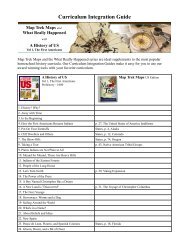Figgy Pudding Stollen and Tamales - Knowledge Quest
Figgy Pudding Stollen and Tamales - Knowledge Quest
Figgy Pudding Stollen and Tamales - Knowledge Quest
You also want an ePaper? Increase the reach of your titles
YUMPU automatically turns print PDFs into web optimized ePapers that Google loves.
<strong>Figgy</strong> <strong>Pudding</strong><br />
<strong>Stollen</strong> <strong>and</strong> <strong>Tamales</strong><br />
Gathering the World Around<br />
Your Christas Table
<strong>Figgy</strong> <strong>Pudding</strong><br />
<strong>Stollen</strong> <strong>and</strong> <strong>Tamales</strong><br />
Gathering the World Around<br />
A Free Christmas Cookbook<br />
Compliments of
<strong>Figgy</strong> <strong>Pudding</strong>, <strong>Stollen</strong> <strong>and</strong> <strong>Tamales</strong><br />
Gathering the World Around<br />
2
Gather the World Around Your Christmas Table<br />
Table of Contents<br />
<strong>Tamales</strong> of Mexico (Simple Recipe) 5<br />
<strong>Tamales</strong> of Mexico (Traditional Recipe) 7<br />
Pavlova of New Zeal<strong>and</strong> 8<br />
<strong>Figgy</strong> <strong>Pudding</strong> of the UK 12<br />
Baked Apples of Sweden 14<br />
Rice <strong>Pudding</strong> of Sweden 15<br />
Beurrée de Crème of Quebec, Canada 16<br />
Sorrel Punch of Jamaica 17<br />
Panforte of Italy 18<br />
Yorkshire <strong>Pudding</strong> of the UK 20<br />
Babinka of the Philippines 22<br />
Lebkuchen of Germany 23<br />
Kringle of Denmark 25<br />
Santa Lucia Bread of Sweden 26<br />
<strong>Stollen</strong> of Germany 28<br />
3
<strong>Figgy</strong> <strong>Pudding</strong>, <strong>Stollen</strong> <strong>and</strong> <strong>Tamales</strong><br />
Dear Friends,<br />
We are excited to share this collection of recipes - <strong>Figgy</strong> <strong>Pudding</strong>, <strong>Stollen</strong> <strong>and</strong> <strong>Tamales</strong><br />
- with you! We hope that you will experience the flavors of the world this Christmas<br />
Season. Please feel free to share this Christmas cookbook with your friends <strong>and</strong> family.<br />
Gladly send them to this link - www.<strong>Knowledge</strong><strong>Quest</strong>Maps.com/<strong>Figgy</strong>-<strong>Pudding</strong>.html.<br />
We wish you a very Merry Christmas! (Now bring us some <strong>Figgy</strong> <strong>Pudding</strong>!)<br />
From all of us here at <strong>Knowledge</strong> <strong>Quest</strong><br />
4
Gather the World Around Your Christmas Table<br />
<strong>Tamales</strong> of Mexico<br />
Although tamales hail from the ancient Aztec civilization, when the<br />
need for portable <strong>and</strong> well-preserved food was a necessity, tamales<br />
have become a Christmas tradition in Mexico <strong>and</strong> many other<br />
Latino cultures. As the tamale-making process takes all day <strong>and</strong><br />
requires many h<strong>and</strong>s, it provides the perfect opportunity to come<br />
together <strong>and</strong> reconnect with family <strong>and</strong> friends during the holidays.<br />
Ingredients<br />
12-15 corn husks<br />
¼ cup of shortening or lard<br />
¼ cup of softened butter<br />
2 cups of masa mix, Maseca br<strong>and</strong><br />
2 teaspoons baking powder<br />
2 teaspoons salt<br />
1 cup of lukewarm water<br />
½ cup of shredded cheddar cheese<br />
Directions<br />
Sweet variation - add ½ cup of raisins instead of cheese <strong>and</strong> 2 tablespoons of cinnamon sugar<br />
to mixture before steaming.<br />
Fill large pot with water <strong>and</strong> bring to a boil. Remove from heat <strong>and</strong> soak corn husks for 30 minutes<br />
to soften. Drain <strong>and</strong> dab dry on tea towel.<br />
Use a st<strong>and</strong> or h<strong>and</strong> mixer to blend the shortening, butter <strong>and</strong> baking powder. Whip until fluffy.<br />
In a large bowl, mix together the masa mix, salt <strong>and</strong> warm water. Knead to form a soft dough.<br />
Add by small amounts to the shortening/butter mixture until all has been added <strong>and</strong> the mixture<br />
is smooth. Add cheese <strong>and</strong> fold in. Optional: mix in 1 can of corn for chunky texture.<br />
Lay out a husk <strong>and</strong> add about ¼ to ⅓ of a cup of dough to the center <strong>and</strong> spread out. Fold the<br />
narrow end of the husk up to the center, then fold both sides together to enclose the filling. The<br />
sticky masa will form a seal. Pinch the wide top closed. Repeat with the remaining dough.<br />
Steam the tamales for 1 hour. Let them cool a few minutes before serving. Serve with sour<br />
cream <strong>and</strong> salsa. Or, for a sweeter Christmas breakfast, follow sweet variation <strong>and</strong> top with just<br />
sour cream.<br />
5
<strong>Figgy</strong> <strong>Pudding</strong>, <strong>Stollen</strong> <strong>and</strong> <strong>Tamales</strong><br />
6
Gather the World Around Your Christmas Table<br />
Traditional <strong>Tamales</strong> of Mexico<br />
Ingredients<br />
2 pounds pork shoulder roast<br />
Salt <strong>and</strong> pepper, to taste<br />
2 onions, peeled <strong>and</strong> sliced<br />
1 garlic bulb, cloves removed <strong>and</strong> peeled<br />
4 ounces dried New Mexico chilies<br />
2 ounces ancho chiles<br />
2 ounces pasilla chiles<br />
2 tablespoons cumin seed, toasted<br />
1 tablespoons salt<br />
2 bags dried corn husks, about 3 dozen<br />
4 cups masa mix<br />
1 tablespoon baking powder<br />
2 teaspoons salt<br />
4 cups reserved pork broth, warm<br />
1 cup pork lard<br />
Directions<br />
Season the pork shoulder all over with salt <strong>and</strong> pepper then brown in a large heavy pot over<br />
medium heat. Once browned on all sides, add enough water to cover the roast along with the<br />
1 sliced onion <strong>and</strong> about 6 cloves of garlic. Cook until the meat is fork tender <strong>and</strong> comes apart<br />
with no resistance, about 2 hours. When done, remove the roast to a platter to cool, reserve the<br />
pork broth. H<strong>and</strong> shred the meat <strong>and</strong> set aside.<br />
To prepare the sauce, remove the tops of the dried chilies <strong>and</strong> shake out most of the seeds.<br />
Place the chilies in a large stockpot <strong>and</strong> cover them with water. Add the cumin, remaining sliced<br />
onion <strong>and</strong> garlic. Boil for 20 minutes until the chiles are very soft. Transfer the chiles to a blender<br />
using tongs <strong>and</strong> add a ladle full of the chile water (it is best to do this in batches.) Puree the<br />
chiles until smooth. Pass the pureed chiles through a strainer to remove the remaining seeds<br />
<strong>and</strong> skins. Pour the chili sauce into a large bowl <strong>and</strong> add salt, stir to incorporate. Taste to check<br />
seasonings, add more if necessary. Add the shredded pork to the bowl of chili sauce, <strong>and</strong> mix<br />
thoroughly. Refrigerate until ready to use.<br />
Go through the dried cornhusks, separate them <strong>and</strong> discard the silk, be careful since the husks<br />
are fragile when dry. Soak them in a sink filled with hot water for 30 minutes to soften. In a deep<br />
bowl, combine the masa, baking powder, <strong>and</strong> salt. Pour the broth into the masa a little at a time,<br />
working it in with your fingers. In a small bowl, beat the pork lard until fluffy. Add it to the masa<br />
<strong>and</strong> beat until the dough has a spongy texture.<br />
Rinse, drain, <strong>and</strong> dry the corn husks. Set them out on a sheet pan covered by a damp towel<br />
along with the bowls of masa dough <strong>and</strong> pork in chile sauce. Start with the largest husks because<br />
they are easier to roll. Lay the husk flat on a plate or in your h<strong>and</strong> with the smooth side up<br />
<strong>and</strong> the narrow end facing you. Spread a thin, even layer of masa over the surface of the husk<br />
with a tablespoon dipped in water. Do not use too much! Add about a tablespoon of the meat filling<br />
in the center of the masa. Fold the narrow end up to the center then fold both sides together<br />
to enclose the filling. The sticky masa will form a seal. Pinch the wide top closed.<br />
St<strong>and</strong> the tamales up in a large steamer or col<strong>and</strong>er with the pinched end up. Load the steamer<br />
into a large pot filled with 2-inches of water. The water should not touch the tamales. Lay a<br />
7
<strong>Figgy</strong> <strong>Pudding</strong>, <strong>Stollen</strong> <strong>and</strong> <strong>Tamales</strong><br />
damp cloth over the tamales <strong>and</strong> cover with lid. Keep the water at<br />
a low boil, checking periodically to make sure the water doesn’t boil<br />
away. Steam the tamales for 2 hours.<br />
The tamales are done when the inside pulls away from the husk.<br />
The tamale should be soft, firm <strong>and</strong> not mushy. To serve, unfold the<br />
husk <strong>and</strong> spoon about a tablespoon of remaining pork filling on top.<br />
Pavlovas of New Zeal<strong>and</strong><br />
After the Russian ballerina Anna Pavlova visited New Zeal<strong>and</strong> in 1926, cooks <strong>and</strong> chefs captivated<br />
by her solo performance as the dying swan in Swan Lake, created for her by Michel Folkine<br />
in 1905, sought to honor her <strong>and</strong> the occasions of her visit with confections they created to<br />
capture her light <strong>and</strong> airy spirit onstage. Over the decades to follow, the refined <strong>and</strong> traditional<br />
Pavlova became a Christmas staple.<br />
8
Gather the World Around Your Christmas Table<br />
Pavlovas of New Zeal<strong>and</strong><br />
Ingredients<br />
Meringue:<br />
1 1/2 teaspoons vanilla extract<br />
1/2 teaspoon cream of tartar OR 2 teaspoons white wine vinegar<br />
OR distilled white vinegar<br />
1 1/2 Tbsp cornstarch<br />
1 1/2 cups granulated sugar<br />
6 large egg whites, preferably room temperature<br />
Pinch salt<br />
Topping:<br />
4 cups fresh or frozen berries<br />
1/4 cup sugar<br />
Whipped Cream for topping<br />
Directions<br />
Place rack in the middle of the oven <strong>and</strong> preheat the oven to 275°. Line a large baking sheet<br />
with parchment paper or silicon liner. Pour the vanilla <strong>and</strong> vinegar (if using) into a small cup. Stir<br />
the cornstarch into the sugar in a small bowl.<br />
In a large bowl of a st<strong>and</strong> mixer, fitted with the whisk attachment, whip the egg whites, cream of<br />
tartar (if using) <strong>and</strong> salt, starting on low, increasing slowly to medium speed until soft peaks or<br />
trails begin to form, about 2 to 3 minutes.<br />
Increase speed to medium-high, slowly <strong>and</strong> gradually sprinkling in the sugar-cornstarch mixture.<br />
Mix for 2 minutes then slowly pour in the vanilla <strong>and</strong> vinegar (if you didn’t use cream of tartar.)<br />
Increase speed <strong>and</strong> whip until meringue is glossy, <strong>and</strong> stiff peaks form when the whisk is lifted,<br />
about 4 to 5 minutes.<br />
Pipe or spoon the meringue into 8-10 large round mounds that are 3 inches wide on the baking<br />
sheet lined with parchment paper or a silicon liner. With the back of a spoon, create an indentation<br />
in the middle of the mound for holding the filling once meringue is baked.<br />
Place baking sheet in the oven. Reduce oven temperature to 250°F. Bake for 50-60 minutes,<br />
or until the meringues are crisp, dry to the touch on the outside, <strong>and</strong> white. Do not bake until<br />
tan-colored or cracked. The interiors should have a soft, marshmallow-like consistency. Check<br />
on meringues at least once during the baking time. If they appear to be taking on color or cracking,<br />
reduce temperature 25 degrees, <strong>and</strong> turn pan around.<br />
9
<strong>Figgy</strong> <strong>Pudding</strong>, <strong>Stollen</strong> <strong>and</strong> <strong>Tamales</strong><br />
Pavlova, continued...<br />
Gently lift meringues from the baking sheet <strong>and</strong> cool on a wire rack.<br />
Use right away or store meringues in a tightly sealed container at<br />
room temperature for up to a week.<br />
Served topped with your favorite filling - lemon curd, raspberry or<br />
blueberry sauce (see below) <strong>and</strong> freshly whipped cream.<br />
If you want to make a berry sauce, heat 4 cups of fresh or frozen berries in a medium saucepan<br />
with a quarter cup of sugar. Heat on medium heat, stirring once or twice, for about 5 to 10 minutes,<br />
depending on how much the berries are falling apart. Remove from heat <strong>and</strong> let cool.<br />
Yield: Makes 8-10 pavlovas.<br />
Kolaches of Czechoslovakia<br />
This recipe has been passed down through my Gr<strong>and</strong>mother Rosell’s family<br />
A sweet pastry dough holding a dollop of fruit, kolaches date as far back as the 1700s in eastern<br />
Europe <strong>and</strong> came to America with the Czechs who settled in Texas.<br />
Dough<br />
2 pkgs. dry yeast<br />
1/2 cup sugar<br />
1/4 cup warm water<br />
2 teaspoons salt<br />
1 tablespoon sugar<br />
5 1/4 cups sifted flour<br />
2 cups milk<br />
2 egg yolks, slightly beaten<br />
1/2 cup butter or oleo<br />
1 cup flour sifted<br />
Directions<br />
Dissolve yeast in warm water. Add 1 tablespoon sugar <strong>and</strong> let st<strong>and</strong>. Heat milk in saucepan until<br />
pretty hot, almost scalding. Do not boil. Remove from heat <strong>and</strong> stir in butter or oleo <strong>and</strong> 1/2 cup<br />
sugar. Cool to lukewarm <strong>and</strong> add yeast mixture. In large bowl combine salt <strong>and</strong> 5 1/4 cups flour.<br />
Add the yeast <strong>and</strong> milk mixture to flour <strong>and</strong> mix. Mix in egg yolks. Mix in enough of last cup of<br />
flour for desired texture, not sticky. Knead on floured board until glossy smooth. Grease large<br />
bowl <strong>and</strong> place the dough in the bowl, turning to grease dough completely. Cover <strong>and</strong> let it rise<br />
in warm place until double in bulk. Roll out dough to about 1/2 inch thick <strong>and</strong> cut into individual<br />
kolaches with biscuit cutter. In the center, spoon in filling of your choice. Fold over <strong>and</strong> pinch<br />
to close. Place on greased pan so not quite touching. Brush with melted butter or oleo <strong>and</strong> let<br />
rise again covered until light to touch. Bake in 375 degree oven until brown, about 25 minutes.<br />
Remove <strong>and</strong> brush with melted butter again.<br />
10
Gather the World Around Your Christmas Table<br />
Poppy Seed Filling<br />
1 1/2 cups milk<br />
1 cup ground poppy seed<br />
1 tablespoon flour<br />
1 teaspoon vanilla<br />
1 1/4 cups sugar<br />
1 teaspoon butter or oleo<br />
Heat milk <strong>and</strong> when it boils add sugar, flour <strong>and</strong> poppy seed, stirring vigorously. Cook over<br />
medium heat until mixture thickens. Remove from heat. Add butter or margarine <strong>and</strong> then add<br />
vanilla. Cool filling before adding to kolaches dough. Spoon about one teaspoon filling in each<br />
kolache.<br />
Prune Filling<br />
1 lb. pitted prunes<br />
4 c. water<br />
1/2 c. sugar<br />
Dash of nutmeg<br />
11
<strong>Figgy</strong> <strong>Pudding</strong>, <strong>Stollen</strong> <strong>and</strong> <strong>Tamales</strong><br />
Kolaches, continued...<br />
Boil prunes <strong>and</strong> water until soft. Add sugar <strong>and</strong> nutmeg. Simmer<br />
until thick. Cool completely.<br />
Glaze<br />
2 cups powdered sugar<br />
1/2 teaspoon vanilla<br />
2 tablespoons butter<br />
4 tablespoons milk<br />
Combine ingredients. Spoon over kolaches while still warm.<br />
<strong>Figgy</strong> <strong>Pudding</strong>s of the UK<br />
Dating back as far as the 16th Century, <strong>Figgy</strong> <strong>Pudding</strong> is a Christmas staple generously shared<br />
with carolers throughout the UK during Christmastime. It was later immortalized in the cherished<br />
Christmas carol, “We Wish You A Merry Christmas.” Now ... bring us some figgy pudding!<br />
12
Gather the World Around Your Christmas Table<br />
<strong>Figgy</strong> <strong>Pudding</strong><br />
Ingredients<br />
1 1/2 cups chopped dried pitted dates<br />
1/2 cup chopped dried figs<br />
2 cups water<br />
1 teaspoon baking soda<br />
7 tablespoons butter, softened<br />
1 cup sugar<br />
2 eggs<br />
2 1/2 cups self-rising flour<br />
2 1/2-ounces dark chocolate, grated<br />
Butter, for coating ramekins<br />
Ice cream or whipped cream, for topping<br />
Sauce<br />
2 cups brown sugar<br />
2 cups heavy cream<br />
7-ounces, or 14 tablespoons, butter<br />
Fresh figs, quartered, for garnish<br />
Vanilla ice cream, optional<br />
Whipped heavy cream, optional<br />
Directions<br />
Preheat oven to 350 degrees F.<br />
Add the dates, figs <strong>and</strong> water to a medium saucepan <strong>and</strong> bring to boil over medium heat. Remove<br />
the pan from the heat <strong>and</strong> stir in the baking soda. Let cool for about 5 minutes, then add<br />
to a blender <strong>and</strong> puree.<br />
Using a h<strong>and</strong> mixer, cream the butter <strong>and</strong> sugar in a large bowl. Add the eggs <strong>and</strong> beat well.<br />
Fold in the flour, the pureed date mixture <strong>and</strong> the grated chocolate. Pour the mixture into 4 buttered,<br />
1-cup individual ramekins, filling halfway or slightly less. Place in the oven <strong>and</strong> bake for<br />
20 to 25 minutes.<br />
Prepare the sauce by stirring the sugar, cream <strong>and</strong> butter in a medium saucepan over low heat.<br />
Simmer until the sugar dissolves. Raise the heat <strong>and</strong> bring to a boil, then reduce the heat <strong>and</strong><br />
simmer for 5 minutes more. Add the butter <strong>and</strong> stir until incorporated.<br />
Remove the ramekins from the oven <strong>and</strong> let st<strong>and</strong> for 10 minutes. Serve directly in the ramekin<br />
or unmolded onto a small serving plate. Cut a cross on the top of the puddings for the sauce.<br />
Pour the sauce into the cross in the center of each pudding, then pour more sauce over the<br />
puddings <strong>and</strong> allow it to soak in slightly. Top with fresh figs <strong>and</strong> vanilla ice cream or whipped<br />
cream. Serve warm.<br />
13
<strong>Figgy</strong> <strong>Pudding</strong>, <strong>Stollen</strong> <strong>and</strong> <strong>Tamales</strong><br />
Ugnsbakade Äpplen, or Baked Apples of Sweden<br />
In every Swedish home, December 24th is marked with a Christmas smörgåsbord, a festive<br />
table spread with a battery of traditional Christmas dishes, of which baked apples is one. Like<br />
American office parties, Swedish business owners routinely treat their employees to a smörgåsbord<br />
in the weeks before Christmas.<br />
Ingredients<br />
6 granny smith apples<br />
1⁄2 cup light Swedish syrup (or light corn syrup)<br />
3 tbsp. butter<br />
Freshly whipped cream<br />
Optional: Chopped walnuts or pecans<br />
Optional: Raspberries or lingonberries<br />
Directions<br />
Preheat oven to 425°. Peel <strong>and</strong> core apples leaving the bottom of the apples intact, so that you<br />
have a well. Place apples right side up in a medium baking dish. Drizzle with syrup, dot with butter,<br />
<strong>and</strong> sprinkle with nuts (optional). Bake, basting occasionally with pan juices, until soft, about<br />
35 minutes. Serve warm with berries <strong>and</strong> freshly whipped cream.<br />
Serves 6.<br />
14
Gather the World Around Your Christmas Table<br />
Risgrynspudding, or Rice <strong>Pudding</strong> of Sweden<br />
At Christmas, Swedish rice pudding is served with a whole almond<br />
hidden within the sweetly spiced dish, <strong>and</strong> a year’s worth of luck is<br />
promised to the happy one who finds it.<br />
Ingredients<br />
8 cups milk<br />
1 1⁄4 cups arborio rice<br />
1⁄3 cup sugar, plus 2 tbsp.<br />
1 1⁄2 tsp. vanilla extract<br />
2 cups fresh or frozen raspberries<br />
1 1⁄2 cups heavy cream<br />
Nutmeg<br />
Directions<br />
Place milk in a medium saucepan <strong>and</strong> bring to a boil over medium-high heat. Stir in rice <strong>and</strong> 1⁄3<br />
cup of the sugar. Reduce heat to medium-low <strong>and</strong> simmer, stirring frequently, until rice is tender<br />
15
<strong>Figgy</strong> <strong>Pudding</strong>, <strong>Stollen</strong> <strong>and</strong> <strong>Tamales</strong><br />
<strong>and</strong> most of liquid has been absorbed, about 45 minutes.<br />
Remove pudding from heat <strong>and</strong> stir in vanilla extract. Allow to cool.<br />
Meanwhile, place berries in a food processor, add remaining 2<br />
tbsp. of sugar, <strong>and</strong> purée until smooth. Set aside.<br />
Just before serving, whip heavy cream. Fold cream into pudding<br />
<strong>and</strong> transfer into bowls. Spoon raspberry sauce around edge of<br />
pudding <strong>and</strong> sprinkle with nutmeg.<br />
Serves 6.<br />
Beurrée de Crème avec Sucre d’Érable (Cream-soaked White Bread)<br />
of Quebec, Canada<br />
On the snowy eve of Christmas, the bundled-up city-dwellers of Quebec become nostalgic <strong>and</strong><br />
find warmth indoors among family <strong>and</strong> friends, seeking the traditional comfort foods of Eastern<br />
Canada <strong>and</strong> their distant mother-country of France. Rich dishes, both savory <strong>and</strong> sweet, faintly<br />
originating from the French countryside, have been re-crafted to become Canadia’s own - warm<br />
<strong>and</strong> crusty Tourtière (pork pie) followed by the utterly simple but fabulously satisfying crunch<br />
of the sugar-topped cream soaked bread known as Beurrée de Crème avec Sucre d’Érable.<br />
The apron-clad hostess “is quick to clarify that she considers France only a distant relation, the<br />
source from which Quebec’s culture trickled before it became a thriving independent river. ‘We<br />
speak French, but we are not French,’ she says with a sniff, <strong>and</strong> sinks her teeth into another<br />
spoonful of beurrée de crème.”<br />
Ingredients<br />
3/4 cup heavy cream<br />
4 thick slices of hearty white country bread<br />
4 tbsp. coarsely grated maple sugar or crystallized sugar<br />
Directions<br />
Put cream into a medium bowl, <strong>and</strong> whisk until slightly<br />
thickened. Pour 1/4 cup of the cream over each slice of<br />
bread. Sprinkle 1 tbsp. of the maple sugar over the cream.<br />
Serve immediately.<br />
Serves 4.<br />
16
Gather the World Around Your Christmas Table<br />
Sorrel Punch of Jamaica<br />
Sorrel punch is a traditional Christmas beverage in the Caribbean. Dried hibiscus flowers —<br />
known as “sorrel” in Jamaica but not to be confused with the pungent green found in the states<br />
— can be purchased in most Caribbean or Latin markets. In West Africa the same flowers are<br />
known as roselle or bissap. Nigerians drink a similar beverage called zobo.<br />
Ingredients<br />
2 cups dried hibiscus flowers (sorrel)<br />
¼ cup minced ginger<br />
8 cups boiling water<br />
1 to 1 ¼ cups sugar<br />
Directions<br />
Place hibiscus flowers <strong>and</strong> minced ginger in a large bowl <strong>and</strong> pour over the boiling water. Cover<br />
<strong>and</strong> let steep for several hours at room temperature.<br />
Strain into a large pitcher <strong>and</strong> stir in sugar to taste. Serve well chilled. Makes about 1 1/2<br />
quarts.<br />
17
<strong>Figgy</strong> <strong>Pudding</strong>, <strong>Stollen</strong> <strong>and</strong> <strong>Tamales</strong><br />
Sorrel Punch, continued...<br />
Variations<br />
Add a few allspice berries or a stick of cinnamon the the steeping<br />
hibiscus <strong>and</strong> ginger if you like.<br />
Use only 4 cups boiling water to steep. Add 4 cups of seltzer water after straining <strong>and</strong> chilling for<br />
a bubbly beverage.<br />
Mix with a shot of rum <strong>and</strong> a garnish of lime for a nice cocktail.<br />
Panforte of Italy<br />
Panforte is a traditional Italian dessert containing fruits <strong>and</strong> nuts, <strong>and</strong> resembles fruitcake or<br />
Lebkuchen. It dates back as early as the 13th century in Siena, a town in Italy’s Tuscany region.<br />
Documents from the year 1205 show that panforte was paid to the monks <strong>and</strong> nuns of a local<br />
monastery as a tax or tithe which was due on the seventh of February that year. There are references<br />
to the Crusaders carrying panforte, a durable confection, with them on their journeys, <strong>and</strong><br />
aiding medieval city-dwellers in surviving sieges. Literally, panforte means “strong bread” which<br />
refers to the spicy flavor.<br />
Ingredients<br />
3 ounces semi-sweet chocolate, chopped<br />
1 cup toasted <strong>and</strong> coarsely chopped hazelnuts<br />
1 cup toasted <strong>and</strong> coarsely chopped almonds<br />
1 cup c<strong>and</strong>ied citrus (lemon <strong>and</strong>/or orange peel)<br />
1 teaspoon cinnamon<br />
1/4 teaspoon allspice<br />
1/2 cup all purpose flour<br />
1 tablespoon unsweetened cocoa powder<br />
2/3 cup white sugar<br />
2/3 cup honey<br />
Directions<br />
Butter <strong>and</strong> line with parchment paper an 8-inch tart pan with removable sides. Alternatively, <strong>and</strong><br />
for a more authentic look, line the pan with edible rice paper (available at Asian markets).<br />
Melt the chocolate in a double-boiler or a stainless steel bowl placed over a saucepan of simmering<br />
water. Set aside. In a large bowl, combine the nuts, c<strong>and</strong>ied fruit, spices, flour, <strong>and</strong><br />
cocoa powder.<br />
In a saucepan, stir together the sugar <strong>and</strong> honey. Place the saucepan over medium heat <strong>and</strong><br />
bring to a boil, stirring until sugar has dissolved. Using a c<strong>and</strong>y thermometer, continue to boil the<br />
mixture over medium heat, without stirring, until the temperature reaches the soft ball stage, 240<br />
degrees F.<br />
18
Gather the World Around Your Christmas Table<br />
Panforte, continued...<br />
Remove from heat <strong>and</strong> stir the sugar/honey syrup <strong>and</strong> the melted chocolate into the chopped<br />
nut <strong>and</strong> fruit mixture. The mixture will stiffen once combined, so quickly transfer to the prepared<br />
pan. With damp h<strong>and</strong>s, or the back of a large spoon, evenly spread the Panforte in the pan,<br />
smoothing the top.<br />
Bake in a 300 degree F oven for about 30 - 35 minutes or until the surface has fine blisters. Remove<br />
from oven <strong>and</strong> place on a wire rack to cool. While the Panforte is still warm, remove the<br />
sides of the pan <strong>and</strong> generously dust the top of the cake with confectioners’ sugar.<br />
Once the cake has cooled completely, wrap it tightly in plastic wrap <strong>and</strong> store in a cool, dry<br />
place. When well wrapped, this cake will keep several months.<br />
Serve cake in thin slices as it is quite rich.<br />
Makes 1 - 8 inch cake.<br />
19
<strong>Figgy</strong> <strong>Pudding</strong>, <strong>Stollen</strong> <strong>and</strong> <strong>Tamales</strong><br />
Yorkshire <strong>Pudding</strong> of the United Kingdom<br />
Recipe from Aunt Debbie<br />
Yorkshire <strong>Pudding</strong>, also known as batter or dripping pudding, is a dish named after Yorkshire,<br />
Engl<strong>and</strong>, although there is no evidence it originated from there. When wheat flour became more<br />
common for making cakes <strong>and</strong> puddings, cooks in the north of Engl<strong>and</strong> devised a means of<br />
making use of the fat that dropped into the dripping pan to cook a batter pudding while the meat<br />
roasted in the oven. A recipe for ‘A dripping pudding’ was first published in 1737 in The Whole<br />
Duty of a Woman. Similar instructions were published 10 years later in The Art of Cookery made<br />
Plain <strong>and</strong> Easy by Hannah Glasse under the title of ‘Yorkshire pudding’. It was she who re-invented<br />
<strong>and</strong> renamed the original version. A 2008 ruling by the Royal Society of Chemistry has it<br />
that “A Yorkshire pudding isn’t a Yorkshire pudding if it is less than four inches tall.”<br />
Ingredients<br />
1 cup flour<br />
1/2 teaspoon salt<br />
1 cup milk<br />
2 Tbsp melted butter<br />
2 eggs, beaten<br />
¼ cup of roast drippings (or melted butter)<br />
20
Gather the World Around Your Christmas Table<br />
Yorkshire <strong>Pudding</strong>, continued...<br />
Directions<br />
Sift together the flour <strong>and</strong> salt in a large bowl. Form a well in the center. Add the milk <strong>and</strong> melted<br />
butter <strong>and</strong> beat until fluffy. Add the eggs <strong>and</strong> beat until the batter is completely smooth <strong>and</strong> large<br />
bubbles rise to the surface. Use immediately or let sit for up to an hour.<br />
Heat oven to 425°F. Add roast drippings to a 9x12-inch pyrex or ceramic casserole dish, coating<br />
the bottom of the dish. Heat the dish in the oven for 10 minutes.<br />
(For a popover version you can use a popover pan or a muffin pan, putting at least a teaspoon<br />
of drippings in the bottom of each well, <strong>and</strong> place in oven for just a couple minutes.)<br />
Carefully pour the batter into the pan (or the wells of muffin/popover pans, filling just 1/3 full),<br />
once the pan is hot. Cook for 15 minutes at 425°F, then reduce the heat to 350°F <strong>and</strong> cook for<br />
another 15 to 20 minutes, until puffy <strong>and</strong> golden brown.<br />
Cut into squares <strong>and</strong> serve at once. Serves 6.<br />
Bibingka of the Philippines (Gluten-Free)<br />
During the Christmas season in the Philippine Isl<strong>and</strong>s, bibinkga, a sweet <strong>and</strong> spongy rice cake,<br />
are traditionally sold outside churches. This native delicacy is related to the “misa de gallo” or<br />
the simbang gabi, the dawn mass celebrated for nine days before Christmas Day. Bibingka is<br />
also common as a street food, cooked in the traditional way, wrapped in banana leaves <strong>and</strong><br />
cooked over live coals inside clay pots. The cakes are moist <strong>and</strong> mildly sweet <strong>and</strong> the sliced<br />
salted eggs <strong>and</strong> the grated coconut with sugar on top give them a distinctly delightful flavor <strong>and</strong><br />
texture. The freshly-baked bibingka is spread with butter then served with additional niyog (grated<br />
coconut).<br />
Ingredients<br />
1 (13.5-ounce) can coconut milk<br />
1 (14-ounce) can sweetened condensed milk<br />
1/2 cup butter, melted<br />
6 eggs<br />
2 (12-ounce) jars macapuno coconut strings<br />
in heavy syrup*<br />
1 (16-ounce) box mochiko sweet rice flour*<br />
1 cup packed brown sugar<br />
1/4 cup wheat germ (or finely chopped almonds<br />
for a gluten-free recipe)<br />
1 tablespoon vanilla extract<br />
Ground cinnamon<br />
* Look for these specialty ingredients at a local Asian market, if you have one in your area.<br />
21
<strong>Figgy</strong> <strong>Pudding</strong>, <strong>Stollen</strong> <strong>and</strong> <strong>Tamales</strong><br />
Bibingka, continued...<br />
Directions<br />
Preheat oven to 375°. Line a 13” x 18” baking/cookie sheet with parchment paper.<br />
In a large mixing bowl, beat coconut milk, condensed milk, <strong>and</strong> melted butter until combined.<br />
Add eggs, one at a time, <strong>and</strong> beat until combined. Do the same with both jars of macapuno<br />
strings. Gradually beat in mochiko flour (do not pour all at once or it will get lumpy). Next add<br />
the brown sugar <strong>and</strong> wheat germ <strong>and</strong> mix well. Once you achieve an even consistency, add<br />
vanilla extract <strong>and</strong> beat until incorporated.<br />
Pour batter onto the lined cookie sheet. Bake until lightly browned, about 45 minutes. Sprinkle<br />
cinnamon evenly over the cake. Continue to bake until golden brown <strong>and</strong> a toothpick inserted in<br />
the center comes out clean, between 2 <strong>and</strong> 15 minutes longer.<br />
Remove from pan <strong>and</strong> let cool on the parchment paper. Once cooled, cut into to 2-inch squares.<br />
A pizza cutter works well.<br />
Store in an airtight container at room temperature for 1 to 2 days or in the refrigerator for 1 to 2<br />
weeks.<br />
22
Gather the World Around Your Christmas Table<br />
Lebkuchen of Germany<br />
Lebkuchen (also known as Pfefferkuchen) is a traditional German Christmas treat, somewhat<br />
resembling gingerbread, but topped with blanched almonds. Lebkuchen were invented by medieval<br />
monks in Franconia, Germany during the 13th century. Bakers of lebkuchen were recorded<br />
as early as 1296 in Ulm, <strong>and</strong> 1395 in Nuremberg. Local history in Nuremberg relates that emperor<br />
Friedrich III held a Reichstag in 1487 <strong>and</strong> invited all the children of the city to a special<br />
23
<strong>Figgy</strong> <strong>Pudding</strong>, <strong>Stollen</strong> <strong>and</strong> <strong>Tamales</strong><br />
Lebkuchen, continued...<br />
festival where he presented Lebkuchen bearing his printed portrait<br />
to nearly four thous<strong>and</strong> children. Lebkuchen is also known as honey<br />
cake (Honigkuchen) or pepper cake (Pfefferkuchen). Traditionally,<br />
the cookies are usually quite large, up to four <strong>and</strong> a half inches<br />
in diameter.<br />
Ingredients<br />
1/2 cup honey<br />
1/2 cup molasses<br />
3/4 cup brown sugar<br />
1 egg<br />
1 tablespoon lemon juice<br />
1 teaspoon grated lemon zest<br />
2 3/4 cups flour<br />
1/2 teaspoon baking soda<br />
1 ½ teaspoon cinnamon<br />
1 teaspoon cloves<br />
½ teaspoon allspice<br />
½ teaspoon nutmeg<br />
1/3 cup chopped c<strong>and</strong>ied orange or lemon peel<br />
1/2 cup chopped almonds<br />
Plus blanched whole almonds for garnish<br />
1 cup sugar<br />
1/2 cup water<br />
1/2 teaspoon corn syrup<br />
1/4 cup powdered sugar<br />
Directions<br />
In a small saucepan, bring the honey <strong>and</strong> molasses to a boil over high heat. Remove from heat<br />
<strong>and</strong> cool to room temperature.<br />
In a large bowl, combine the cooled honey <strong>and</strong> molasses mixture with the brown sugar, egg,<br />
lemon juice <strong>and</strong> lemon zest.<br />
Sift together the flour, baking soda <strong>and</strong> spices. Stir the dry ingredients into the molasses mixture<br />
until thoroughly combined <strong>and</strong> then stir in the chopped c<strong>and</strong>ied peel <strong>and</strong> nuts.<br />
Cover the dough <strong>and</strong> refrigerate overnight.<br />
Before baking, heat the oven to 400 degrees. Make a glaze for the cookies by following these<br />
directions: In a small saucepan, combine the sugar, water <strong>and</strong> corn syrup over high heat until a<br />
c<strong>and</strong>y thermometer inserted reads 230 degrees. Quickly stir in the powdered sugar <strong>and</strong> remove<br />
from heat. Set the glaze aside in a warm place.<br />
Roll the chilled dough on a floured surface to a thickness of one-fourth inch. Cut the dough into<br />
rectangles approximately 3 inches long <strong>and</strong> 2 inches wide.<br />
24
Gather the World Around Your Christmas Table<br />
Lebkuchen, continued...<br />
Place the cookies at least 1 inch apart on a greased baking sheet.<br />
Place 1 blanched almond in the center of each cookie, then bake<br />
for 10 to 12 minutes. Brush the cookies with a thin coating of the<br />
glaze while still warm, then cool the cookies on a rack. Store the<br />
cookies in an airtight container for a week.<br />
Makes three dozen cookies.<br />
Kringle of Denmark<br />
Recipe from Gr<strong>and</strong>ma Treumer<br />
Since my gr<strong>and</strong>mother was a true Dane <strong>and</strong> an amazing cook (just saying’), we grew up with<br />
the tradition of baking <strong>and</strong> serving Danish Kringle every Christmas morning. In all my 40-something<br />
years, I don’t think I have ever gotten through a Christmas morning without enjoying this<br />
family favorite! Danish Kringle, is truly a favorite treat of the Danes <strong>and</strong> only made for very<br />
special occasions, such as Christmas morning or other such special days. There is a folk tale<br />
surrounding the pastry that goes something like this...<br />
Lars Larson, was on his deathbed in an upstairs bedroom. His doctor had said Lars would last<br />
for only a matter of hours. Lars woke from a deep sleep <strong>and</strong> sniffed. His wife must have just<br />
returned from the bakery, <strong>and</strong> the aroma of freshly baked kringles bought a spark to Lars. He<br />
whispered, “If I could just have a taste of kringle before I die, it would make my dying a little<br />
sweeter.” He mustered every ounce of strength <strong>and</strong> got out of bed. Slowly he made his way<br />
downstairs <strong>and</strong> into the kitchen. there he spied two kringles on the counter. Just as he was<br />
reaching out to take a piece, his wife swatted his h<strong>and</strong> away. “Stop that,” she said. “We’re saving<br />
these for the funeral.”<br />
Ingredients<br />
Crust:<br />
1 cup flour<br />
½ cup butter or margarine<br />
1 teaspoon cold water<br />
Puff:<br />
1 cup water<br />
½ butter or margarine<br />
1 cup flour<br />
3 eggs<br />
½ teaspoon almond extract<br />
25
<strong>Figgy</strong> <strong>Pudding</strong>, <strong>Stollen</strong> <strong>and</strong> <strong>Tamales</strong><br />
Kringle, continued...<br />
Frosting:<br />
1 cup powdered sugar<br />
1 tablespoon butter<br />
1 tablespoon cream<br />
½ teaspoon almond extract<br />
Directions<br />
Preheat oven to 350 degrees.<br />
For crust, add flour <strong>and</strong> pats of butter to bowl. Using pastry blender, blend flour <strong>and</strong> butter until<br />
it resembles coarse cornmeal. Add cold water <strong>and</strong> blend with fork until it begins to stick together<br />
<strong>and</strong> form a ball.<br />
Divide crust into two parts <strong>and</strong> press down with fingers onto cookie sheet into two strips (approximately<br />
3 inches wide by 15 to 18 inches long). Crust strips will be thin. If sticky, put flour on<br />
fingers.<br />
Moving onto “puff” portion of recipe, add 1 cup of water to sauce pan along with ½ cup of butter<br />
or margarine on medium heat. When boiling, remove pan from the stove. Add 1 cup flour (just<br />
dump in <strong>and</strong> stir quickly until smooth. Next, stir in 3 eggs, one at a time. Beat well after each<br />
egg. Add ½ teaspoon of almond extract. Spread this mixture on the two pie crust strips. Bake 50<br />
minutes until puffed up <strong>and</strong> golden brown like a cream puff. It will flatten as it cools.<br />
Mix the powdered sugar, butter <strong>and</strong> cream until frosting consistency. Add almond extract <strong>and</strong><br />
frost the Kringle.<br />
Saffranstőd of Sweden (Santa Lucia Bread)<br />
Recipe from Aunt Gladys<br />
St. Lucia was an Italian saint who has been “adopted” by the Swedes. She was martyred for<br />
her devotion to the poor. It is said that she appeared during a famine in Sweden during the<br />
Middle Ages carrying food to the farmers across Lake Vännern. St. Lucia represents light to the<br />
people of Sweden during the very dark time of winter. In Sweden, the sun is not up very long in<br />
the wintertime. In fact, in the northern part of the country, it doesn’t come up at all. This holiday<br />
celebrates the fact that the days will now get longer.<br />
To honor <strong>and</strong> celebrate St. Lucia, Sweden’s patron saint, a special ceremony is held on December<br />
13th. On the morning of the 13th, the oldest daughter dresses in a special long white<br />
dress with a red ribbon around her waist. She wears white socks, but no shoes, or is barefoot.<br />
A wreath made out of evergreen boughs is placed upon her head. The wreath has 6 - 8 c<strong>and</strong>les<br />
on it. In modern day celebrations, the c<strong>and</strong>les are usually battery powered light bulbs instead<br />
of real c<strong>and</strong>les. The oldest daughter serves coffee <strong>and</strong> special saffron bread, known as Santa<br />
Lucia Bread, to the rest of the family.<br />
26
Gather the World Around Your Christmas Table<br />
Saffranstőd, continued...<br />
Ingredients<br />
8 cups flour<br />
2 ½ cups of lukewarm milk<br />
2 packages of yeast<br />
1 egg<br />
1 teaspoon of saffron (or cardamon)<br />
1 cup melted butter<br />
1 ½ cups of sugar<br />
¼ teaspoon of salt<br />
1 cup of raisins (optional)<br />
ground almonds (optional)<br />
Directions<br />
Preheat oven to 375 degrees for loaves or 425 degrees for buns<br />
Dissolve yeast in ½ cup of lukewarm milk. Mix remaining milk, saffron, sugar, salt, egg, butter<br />
<strong>and</strong> small amount of flour together. Add yeast mixture <strong>and</strong> remaining flour. Beat with wooden<br />
spoon until smooth <strong>and</strong> firm. Sprinkle with flour <strong>and</strong> cover with a towel. Let rise until doubled<br />
in size (approximately 2 hours). Turn out on floured board <strong>and</strong> knead until smooth. Divide into<br />
portions - make a braided loaf shaped into a wreath or individual buns. Place on greased<br />
27
<strong>Figgy</strong> <strong>Pudding</strong>, <strong>Stollen</strong> <strong>and</strong> <strong>Tamales</strong><br />
Saffranstőd, continued...<br />
baking sheets; cover <strong>and</strong> rise. Brush with slightly beaten egg.<br />
Sprinkle with sugar, ground almonds <strong>and</strong> raisins. Bake for 15-20<br />
minutes for loaves (375 degrees) or 5-10 minutes for buns (425<br />
degrees).<br />
<strong>Stollen</strong> of Germany<br />
Historians have traced Christollen, Christ’s stollen, back to about the year 1400 from the town<br />
of Dresden, Germany. The first stollen consisted of only flour, oats <strong>and</strong> water, as regulated by<br />
church doctrine during Advent, but without butter <strong>and</strong> milk (<strong>and</strong> sugar), it was quite tasteless.<br />
Ernst of Saxony <strong>and</strong> his brother Albrecht requested of the Pope lift the ban on butter <strong>and</strong> milk<br />
during the Advent season. The Pope, in what has become known as the famous “butter letter,”<br />
stated that milk <strong>and</strong> butter could be used to bake stollen, with a clear conscience <strong>and</strong> God’s<br />
blessing, for a nominal fee. :) Originally stollen was called Striezel or Struzel, referring to its<br />
shape, <strong>and</strong> was said to represent the baby Jesus wrapped in swaddling clothes.<br />
Around 1560, it became a tradition for the bakers of Dresden to present the King with two<br />
36-pound stollens as a Christmas gift. It took 8 master bakers <strong>and</strong> 8 journeymen to successfully<br />
carry the loaves to the castle. This custom continued for nearly 200 years. Then, in the year<br />
1730, Prince Augustus the Strong asked the Baker’s Guild of Dresden to bake a giant stollen for<br />
his farewell party for the army. The finished stollen was a true masterpiece, weighing in at nearly<br />
2 tons <strong>and</strong> feeding over 24,000 troops.<br />
To commemorate this event, a <strong>Stollen</strong>fest is held each December in Dresden. The bread for the<br />
modern-day <strong>Stollen</strong>fest weighs approximately 2 tons <strong>and</strong> measures over 4 meters long. Each<br />
year the massive stollen bread is paraded through the city center, then sliced <strong>and</strong> sold to the<br />
public, with the proceeds supporting several local charities. Although there is a basic recipe for<br />
making the original Dresden Christollen, each chef, each village <strong>and</strong> each home baker has their<br />
own secret recipe passed down from generation to generation. There are probably as many<br />
recipes for stollen as there are bakers who bake it. The commercial recipe for Dresden stollen is<br />
closely guarded <strong>and</strong> licensed to ensure quality <strong>and</strong> authenticity.<br />
Ingredients<br />
1/2 cup raisins<br />
1/2 cup dried currants<br />
1 cup diced c<strong>and</strong>ied citrus peel<br />
1/2 cup c<strong>and</strong>ied cranberries<br />
1/2 cup br<strong>and</strong>y<br />
4 to 5 cups flour, divided<br />
2 packages active dry yeast<br />
1/2 cup sugar, divided<br />
1/2 cup milk<br />
1 teaspoon salt<br />
1/2 teaspoon vanilla<br />
2 eggs, at room temperature<br />
28
Gather the World Around Your Christmas Table<br />
<strong>Stollen</strong>, continued...<br />
1/2 cup butter, softened<br />
1 (7 oz.) package marzipan<br />
Melted butter<br />
1/4 cup powdered sugar<br />
Directions<br />
Heat the oven to 375 degrees.<br />
In a medium bowl, combine the raisins, currants, c<strong>and</strong>ied peel <strong>and</strong> c<strong>and</strong>ied cranberries. Pour<br />
the br<strong>and</strong>y over the fruit <strong>and</strong> let sit for 1 hour. Drain, reserving the br<strong>and</strong>y. Pat the fruit dry with<br />
paper towels, return to a clean bowl <strong>and</strong> toss with 2 tablespoons of the flour.<br />
In the bowl of a st<strong>and</strong> mixer or other large bowl, sprinkle the yeast over 1/4 cup lukewarm water<br />
<strong>and</strong> stir until dissolved. Stir in 1 teaspoon of the sugar. Let sit about 5 minutes, until the yeast<br />
begins to bubble.<br />
In a small saucepan over medium heat, heat the milk, salt <strong>and</strong> remaining sugar until just lukewarm.<br />
Add the milk mixture, vanilla extract <strong>and</strong> eggs to the yeast mixture <strong>and</strong> beat with the<br />
mixer or by h<strong>and</strong> with a whisk until incorporated. Beat in the reserved br<strong>and</strong>y. Add 2 cups of the<br />
flour <strong>and</strong> beat until smooth. Cut the butter into small pieces <strong>and</strong> beat in. Beat in just enough of<br />
the remaining flour until the dough forms a ball.<br />
29
<strong>Figgy</strong> <strong>Pudding</strong>, <strong>Stollen</strong> <strong>and</strong> <strong>Tamales</strong><br />
<strong>Stollen</strong>, continued...<br />
Turn the dough out onto a lightly floured surface <strong>and</strong> knead until<br />
smooth <strong>and</strong> elastic, approximately 8-10 minutes. Flatten the dough<br />
out, then knead in the c<strong>and</strong>ied fruit, adding flour to the board as<br />
necessary.<br />
Shape the dough into a ball <strong>and</strong> place the dough into a buttered glass bowl. Turn the dough<br />
buttered side up <strong>and</strong> cover with a tea towel. Allow the dough to rise until doubled in bulk, about<br />
2 hours.<br />
Punch down the dough <strong>and</strong> divide into two equal parts. Set one half aside. Roll the other half<br />
into a 12-by-8-inch oval. Brush with melted butter.<br />
Divide the marzipan into quarters <strong>and</strong> roll each quarter into a 12-inch rope. Place two of the<br />
ropes alongside each other along the length of the rolled-out dough, leaving a 2 inch space between<br />
the two ropes in the center of the rolled-out dough. Fold the long side of the dough over<br />
to the center of the oval. Fold over the other long side so that it overlaps the center by about<br />
1 inch, pressing down gently but firmly. Place the finished loaf on a parchment or silicon-lined<br />
cookie sheet. Brush with melted butter. Repeat with the remaining dough.<br />
Allow the two loaves to rise until each has doubled in size. Bake about 30 to 40 minutes until<br />
golden brown. Dust loaves with powdered sugar.<br />
Optional: One cup coarsely chopped dried fruits may be substituted for the c<strong>and</strong>ied fruit. Cover<br />
the dried fruit with boiling water <strong>and</strong> let sit at room temperature for 8 to 12 hours. Drain <strong>and</strong> use<br />
in place of c<strong>and</strong>ied fruit. This bread freezes nicely for up to 6 months. If freezing stollen, do not<br />
sprinkle with confectioners’ sugar. To serve, first thaw the bread, then bake on a baking sheet in<br />
a preheated 375 degree oven for 7 to 10 minutes. Just before serving, sprinkle with confectioners’<br />
sugar.<br />
Merry Christmas<br />
from <strong>Knowledge</strong> <strong>Quest</strong>!<br />
www.<strong>Knowledge</strong> <strong>Quest</strong>Maps.com<br />
30
















